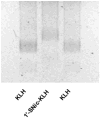Structurally distinct nicotine immunogens elicit antibodies with non-overlapping specificities
- PMID: 22100986
- PMCID: PMC3259188
- DOI: 10.1016/j.bcp.2011.11.004
Structurally distinct nicotine immunogens elicit antibodies with non-overlapping specificities
Abstract
Nicotine conjugate vaccine efficacy is limited by the concentration of nicotine-specific antibodies that can be reliably generated in serum. Previous studies suggest that the concurrent use of 2 structurally distinct nicotine immunogens in rats can generate additive antibody responses by stimulating distinct B cell populations. In the current study we investigated whether it is possible to identify a third immunologically distinct nicotine immunogen. The new 1'-SNic immunogen (2S)-N,N'-(disulfanediyldiethane-2,1-diyl)bis[4-(2-pyridin-3-ylpyrrolidin-1-yl)butanamide] conjugated to keyhole limpet hemocyanin (KLH) differed from the existing immunogens 3'-AmNic-rEPA and 6-CMUNic-BSA in linker position, linker composition, conjugation chemistry, and carrier protein. Vaccination of rats with 1'-SNic-KLH elicited high concentrations of high affinity nicotine-specific antibodies. The antibodies produced in response to 1'-SNic-KLH did not appreciably cross-react in ELISA with either 3'-AmNic-rEPA or 6-CMUNic-BSA or vice versa, showing that the B cell populations activated by each of these nicotine immunogens were non-overlapping and distinct. Nicotine retention in serum was increased and nicotine distribution to brain substantially reduced in rats vaccinated with 1'-SNic-KLH compared to controls. Effects of 1'-SNic-KLH on nicotine distribution were comparable to those of 3'-AmNic-rEPA which has progressed to late stage clinical trials as an adjunct to smoking cessation. These data show that it is possible to design multiple immunogens from a small molecule such as nicotine which elicit independent immune responses. This approach could be applicable to other addiction vaccines or small molecule targets as well.
Copyright © 2011 Elsevier Inc. All rights reserved.
Figures







Similar articles
-
Enhanced immunogenicity of a bivalent nicotine vaccine.Int Immunopharmacol. 2008 Nov;8(11):1589-94. doi: 10.1016/j.intimp.2008.07.001. Epub 2008 Jul 24. Int Immunopharmacol. 2008. PMID: 18656557 Free PMC article.
-
Immunogenicity of individual vaccine components in a bivalent nicotine vaccine differ according to vaccine formulation and administration conditions.PLoS One. 2013 Dec 2;8(12):e82557. doi: 10.1371/journal.pone.0082557. eCollection 2013. PLoS One. 2013. PMID: 24312662 Free PMC article.
-
Active immunization alters the plasma nicotine concentration in rats.J Pharmacol Exp Ther. 1997 Dec;283(3):1076-81. J Pharmacol Exp Ther. 1997. PMID: 9399979
-
New directions in nicotine vaccine design and use.Adv Pharmacol. 2014;69:553-80. doi: 10.1016/B978-0-12-420118-7.00014-7. Adv Pharmacol. 2014. PMID: 24484987 Free PMC article. Review.
-
Cell activation and immunogenicity.Dev Biol Stand. 1986;63:29-39. Dev Biol Stand. 1986. PMID: 3527819 Review.
Cited by
-
Co-administration of morphine and oxycodone vaccines reduces the distribution of 6-monoacetylmorphine and oxycodone to brain in rats.Vaccine. 2012 Jun 29;30(31):4617-24. doi: 10.1016/j.vaccine.2012.04.101. Epub 2012 May 11. Vaccine. 2012. PMID: 22583811 Free PMC article.
-
Optimization of a multivalent peptide vaccine for nicotine addiction.Vaccine. 2019 Mar 14;37(12):1584-1590. doi: 10.1016/j.vaccine.2019.02.003. Epub 2019 Feb 13. Vaccine. 2019. PMID: 30772068 Free PMC article.
-
Opioid Dose- and Route-Dependent Efficacy of Oxycodone and Heroin Vaccines in Rats.J Pharmacol Exp Ther. 2018 May;365(2):346-353. doi: 10.1124/jpet.117.247049. Epub 2018 Mar 13. J Pharmacol Exp Ther. 2018. PMID: 29535156 Free PMC article.
-
Biologics to treat substance use disorders: Current status and new directions.Hum Vaccin Immunother. 2016 Dec;12(12):3005-3019. doi: 10.1080/21645515.2016.1212785. Epub 2016 Jul 21. Hum Vaccin Immunother. 2016. PMID: 27441896 Free PMC article. Review.
-
High immunogenicity of nicotine vaccines obtained by intradermal delivery with safe adjuvants.Vaccine. 2012 Dec 17;31(1):159-64. doi: 10.1016/j.vaccine.2012.10.069. Epub 2012 Oct 30. Vaccine. 2012. PMID: 23123021 Free PMC article.
References
-
- Pentel PR, Keyler DE, Kosten TR. Immunotherapies to treat drug addiction. In: Levine MM, editor. New Generation Vaccines. New York: Dekker; 2009. pp. 982–92.
-
- LeSage MG, Keyler DE, Hieda Y, Collins G, Burroughs D, Le C, et al. Effects of a nicotine conjugate vaccine on the acquisition and maintenance of nicotine self-administration in rats. Psychopharmacology (Berl) 2006;184:409–16. - PubMed
-
- Anton B, Salazar A, Flores A, Matus M, Marin R, Hernandez JA, et al. Vaccines against morphine/heroin and its use as effective medication for preventing relapse to opiate addictive behaviors. Hum Vaccin. 2009;5:214–29. - PubMed
Publication types
MeSH terms
Substances
Grants and funding
LinkOut - more resources
Full Text Sources
Other Literature Sources
Miscellaneous

